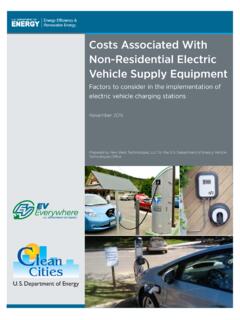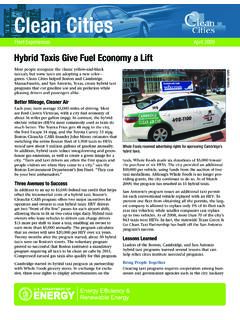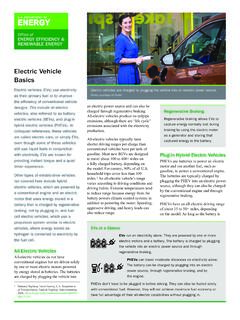Transcription of Electric Vehicle harger Selection Guide
1 Electric Vehicle Charger Selection Guide 1 Acknowledgments This Guide was made possible through the generous support of many organizations. Funding was provided by California Energy Commission grants CEC-ARV-14-046 and CEC-ARV-14-058, as well as financial support from the City of Mount Shasta and the Siskiyou County Economic Development Council. Without hard work from the following representatives of the Redwood Coast Energy Authority, the Schatz Energy Research Center, the Local Government Commission/Civic Spark, and the Siskiyou County Economic Development Council, this Guide would not exist: Redwood Cost Energy Authority.
2 Dana Boudreau Pierce Schwalb Lori Biondini Allison Campbell Lexie Fischer Matthew Marshall Ben Winker Local Government Commission/Civic Spark Amanda Le Schatz Energy Research Center Jerome Carman Andrew Harris Greg Chapman Kristen Radecsky Jim Zoellick Siskiyou County Economic Development Council Logan Smith Disclaimers This report was collaboratively prepared by multiple California government and non-profit agencies as an account of work sponsored by an agency of the State of California. No agency thereof, nor any of their employees, makes any warranty, express or implied, or assumes any legal liability or responsibility for the accuracy, completeness, or usefulness of any information, apparatus, product, or process disclosed, or represents that its use would not infringe privately owned rights.
3 Reference herein to any specific commercial product, process, or service by trade name, trademark, manufacturer, or otherwise does not necessarily constitute or imply its endorsement, recommendation, or favoring by any agency thereof. The views and opinions of authors expressed herein do not necessarily state or reflect those of any agency thereof. LEGAL NOTICE: This document was prepared as a result of work sponsored by the California Energy Commission. It does not necessarily represent the views of the Energy Commission, its employees, or the State of California.
4 The Commission, the State of California, its employees, contractors, and subcontractors make no warranty, express or implied, and assume no legal liability for the information in this document; nor does any party represent that the use of this information will not infringe upon privately owned rights. Public License This report is licensed under the Creative Commons Attribution-ShareAlike International (CC BY-SA ) license. Any entity is free to share (copy and redistribute the material in any medium or format) and adapt (remix, transform, and build upon the material for any purpose, even commercially) under the following terms: Attribution, ShareAlike, and No Additional Restrictions.
5 2 1 Introduction This Guide was funded under multiple grants from the California Energy Commission (CEC). The goal of this Guide is to help site hosts and others learn about, evaluate and compare the features of EV charging equipment (available as of November, 2017) to assist them in selecting a charger for their application. Section 2 in this Guide provides an overview of Electric Vehicle Charger (EVC) equipment, how it works, and considerations when making a purchase. Section 3 includes a table of EVC features available from a variety of commercially available products in the United States.
6 Information on EVC features was collected by sending specification sheets of predetermined criteria to EVC manufacturers with a request for an email response with completed specifications for currently available AC charger models1. Additional information, including that for DC chargers1, was collected using publically available technical specifications. As funding allows, the information in this Guide will be updated periodically to include new models and specifications as product offerings evolve. 2 Selecting an Electric Vehicle Charger: Making Choices While there are many different EVCs to choose from, answering a few questions about what you need in an EVC can make the decision easier: 1.
7 What type of charging do you want to provide? 2. Do you want a networked charger or a stand-alone charger? 3. Do you wish to require payment for access to an EVC? What costs of ownership are you willing to incur? The following sections provide information to help answer these questions, as well as providing some approximate costs associated with installing EVCs. Types of EV Charging Chargers are generally classified in terms of the power they can provide, designated as levels : Level 1 AC charging uses a standard 120 volt AC Electric circuit. Level 2 AC charging uses a 208/240 volt AC Electric circuit.
8 Direct-current fast charger (DCFC), sometimes referred to as a Level 3 DC charging, uses a 3-phase 480 volt AC Electric circuit but delivers direct current (DC) to the Vehicle . 1 AC refers to chargers that provide alternating current (AC) voltage charging. DC refers to chargers that provide direct current (DC) voltage charging. See Section for more information. There are two analogous terms used to describe equipment that charges Electric vehicles: Electric Vehicle Supply Equipment ( evse ) Electric Vehicle Charger (EVC) This Guide uses Electric Vehicle Charger, or EVC, as it describes the function more clearly and also aligns with terminology used in the California Building code .
9 See the end of this Guide for a glossary of common Electric Vehicle charging terms. 3 The charge times will vary depending on the charger, the on-board Vehicle charging equipment, and the Vehicle s battery capacity. The different charging levels serve different consumer needs: DCFCs best suit long-distance trips where time is a premium, while slower chargers work best at locations where people will be parked for long periods. The charging pyramid (Figure 1) illustrates charging levels, typical Vehicle dwell times, and approximate cost. The Charging Pyramid Power Level Vehicle Dwell Time Cost to Charge DC Fast Charging $$$$ High Power AC $$$ Mid Power AC $$ Low Power AC $ Low Power AC (Level 1) Mid-High Power AC (Level 2) DC Fast Charging (DCFC) 120 Volts AC, 12-16 A 2-5 miles of range per hour of charge Typical EVC cost: a few hundred dollars Typical installation cost: $0 208/240 Volts AC, up to 80 Amps 10-20 miles of range per hour of charge Typical EVC cost: $500 - $8,000 Typical installation cost.
10 $600 - $13,000 per charger 200 - 500 VDC, up to 350 A 60-80 miles of range per hour of charge Typical EVC cost: $15,000 - $40,000 Typical installation cost: $8,000 - $50,000 per charger - Charging pyramid courtesy of: Zero-Emission Vehicles in California: COMMUNITY READINESS GUIDEBOOK, accessible at - Costs estimates from two sources: Department of Energy Office of Energy Efficiency and Renewable Energy Fact of the Week #910, and Agenbroad, Josh and Ben Holland. Pulling Back the Veil on EV Charging Station Costs , Rocky Mountain Institute, April 29, 2014.












